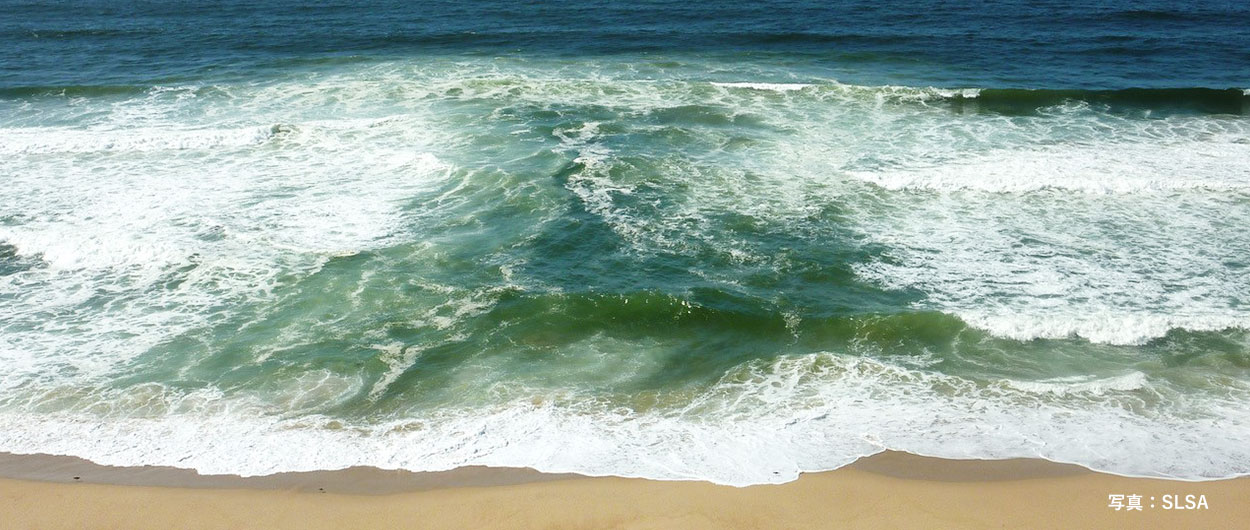WATER SAFETYWatch out for Rip Currents!

60% of drowning accidents are caused by Rip Currents.
At beaches, approximately 60% of drowning accidents are caused by Rip Currents. But that doesn't mean you have to be afraid of the ocean. With the right knowledge, you can avoid Rip Currents and enjoy the beach safely.
How does a Rip Current form?

Example of Rip Current in whitecap conditions
As the waves break, they are converted into shore-directed current energy. This current carries water to the shore and raises the water level. In order to release this water (energy), longshore currents (currents along the shore) are generated and flow offshore in places where the water is deeper than the surrounding area. This is known as Rip Current.
What are the features of a Rip Current?

Strong current going out
On both sides of a Rip Current, waves break. At first glance, you may think that Rip Currents are in calm conditions and are safe because the waves are not breaking as much as those around it. While the size of the wave can give you an idea of the situation, the current is difficult to visualize, so be careful. "Go swim in that quiet place where there are no waves.” This is a dangerous thing to say to your child.
Characteristics
-
The color of the sea is different from the surrounding areas because the sand on the seafloor is rolled up and the sea water is muddy.
-
Bubbles that form after the waves break and/or trash drift out in the ocean.
-
Ripples appear even when the waves are calm.
Where does it form?


Example of a Rip Current survey along a coastal structure. The green tracers can be seen flowing offshore.
On sandy beaches, Rip Currents occur mainly in troughs (concave topography) where the water depth is deeper than the surrounding area. In addition, the shoreline is often curved landward where Rip Currents occur. Even if it is difficult to recognize a Rip Current, it is easy to find where the curved area is, by standing on the shoreline and looking along the coast. You can assume that Rip Currents occur there. In other cases, on coral reefs and rocky shores, Rip Currents (reef currents) are fixed along the depth of the seafloor topography. Also, various coastal structures are installed to protect harbors and beaches in Japan. It is important to note that Rip Currents often occur behind or along these structures.
Rip Currents are also affected by strong offshore winds, tidal currents, near estuaries and river currents. Rip Currents may change scale and place throughout the day, as natural conditions such as waves, tides, winds, and local topographies change as time passes.
How to avoid being swept away by rip currents?

Main currents around coastal structures
Most importantly, do not enter the water where a Rip Current exists.
Do not enter the water where the shoreline is curved landward or around structures, when the waves are not breaking. Even when you enter the water in other places, you may be swept along the shoreline by a longshore current and eventually reach the Rip Current zone which will sweep you offshore. For this reason, it is always a good idea to check the place where you entered the water. For example, if you enter the water in front of a beach house, check to see if you are being swept away from that spot. If you are swept away, you can avoid Rip Currents by going back to shore and entering the water from the original place.
What if I get swept away by Rip Currents?

How to get out of a Rip Current
When a swimmer is swept into a Rip Current, the fear of being swept out can cause panic, and swimming against the current in an attempt to return to shore can lead to exhaustion and drowning. Rip Currents can reach speeds of over 2 meters per second, making it difficult for even Olympic medalists to swim against the current.
So what should you do? Don't Panic, Stop, Think, and then Act. To get out of a Rip Current, a strong swimmer should swim at a 45-degree angle toward the beach to get out. On the other hand, if you are not a strong swimmer or tired, swim parallel to the beach until you reach the point where the Rip Current disappears, i.e., the breaking waves, and then swim back toward the beach.
You will not be swept far out by the Rip Current. Since the current is diffused offshore (at the lip head), it is also a good idea to act after being swept to the lip head while using the "Help" sign to call for help.
The "help me" sign (waving one hand in the air) is a universal help signal at the beach. It is effective when you are sufficiently buoyant, when you are able to stay afloat after beginning to drift, or when you see a drowning person nearby, and want to ask for help from beach lifesavers in a crowded situation.

